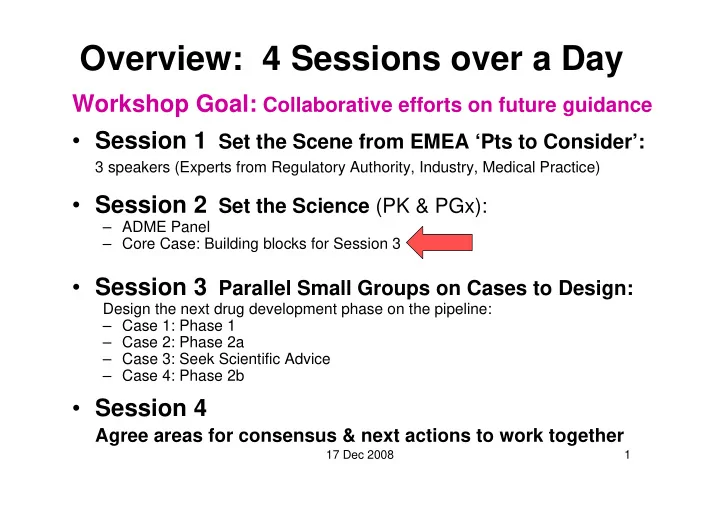

Overview: 4 Sessions over a Day Workshop Goal: Collaborative efforts on future guidance • Session 1 Set the Scene from EMEA ‘Pts to Consider’: 3 speakers (Experts from Regulatory Authority, Industry, Medical Practice) • Session 2 Set the Science (PK & PGx): – ADME Panel – Core Case: Building blocks for Session 3 • Session 3 Parallel Small Groups on Cases to Design: Design the next drug development phase on the pipeline: – Case 1: Phase 1 – Case 2: Phase 2a – Case 3: Seek Scientific Advice – Case 4: Phase 2b • Session 4 Agree areas for consensus & next actions to work together 17 Dec 2008 1
PK & PGx Building Blocks for the Cases in Session 3 Linda Surh, MD PhD GlaxoSmithKline, UK CEDD Global Regulatory Affairs 17 Dec 2008 2
Why PK for Today’s Workshop? Why PK for Today’s Workshop? PK Endpoint of Oral Drugs can be described by 3 primary Parameters: Volume of Absorption Clearance Distribution rate • Knowledge of the physiological function • Well-established drug development process • Correlation between genetic variation & function • Gap? = correlation between genetic variation & drug response 17 Dec 2008 3
Human Responses are Variable Which Variability needs Investigation? PK in All Phase 1 Studies 17 Dec 2008 4 (n=104)
Many Factors contribute to PK Variability Is it possible & useful to determine PGx factor(s)? 17 Dec 2008 5
PK Variability PK Variability The overall variability is a consequence of multiple factors overall variability is a consequence of multiple factors The Which parameter has the largest PGx PGx effect? effect? Which parameter has the largest PK Parameter Distributions in the Population 17 Dec 2008 6
PK Variability PK Variability The overall variability is a consequence of multiple factors overall variability is a consequence of multiple factors The Which parameter has the largest PGx PGx effect? effect? Which parameter has the largest Covariates : Covariates : ‘Noise’: ‘Noise’: Covariates: Covariates: Covariates : : Covariates More Less No PGx PGx No -Assay Assay - + Transporter + + ( AD) M E + ( Diurnal Diurnal PGx PGx -Random Random - PGx PGx Variation Variation PK Parameter Distributions + Gender + Gender -Sample Time Sample Time - + Weight + Weight. . in the Population Volume Physiological Absorption Random Clearance of distrib. status rate error Between-subject variability Within-subject variability Overall Variability in an Endpoint Overall Variability in an Endpoint 17 Dec 2008 7 (In PK, measured by Plasma Concentration or AUC) (In PK, measured by Plasma Concentration or AUC)
Even if there is a statistically significant PGx Correlation with PK Is there clinical relevance? 17 Dec 2008 8
What type of Clinical Relevance in Drug Dev’t? eg Therapeutic Index: ratio between effective & toxic doses Low TI High TI 10 10 Toxicity Magnitude of PGx correlation with PK may have clinical relevance Exposure in a drug with low T.I. (AUC) but not with high T.I. 5 5 Ineffective 0 0 17 Dec 2008 9
* Core Case You are part of a Project Team in Company ABC 17 Dec 2008 10
For Each Case * Workshop Attendees: - Choose 1 Case (out of 4) - Become the Project Team during the case: • Identify who you are and your Expertise • Volunteer for Project Team Leader (to a team decision) • Volunteer for Decision-Table to work with Debriefer, in order to generate 1-2 slides for debrief on key messages which arose during the case discussion Core Case Panel : - Are the experts who developed the case and will be on the Team as: • Project Team Manager (to time session and facilitate process) • Data expert • Debriefer after Session 3 17 Dec 2008 11
Case Background * Drug A is in Early Development Company ABC is developing a second-in-class Drug A for a serious, chronic disease, Diabetes Mellitus Type 2 , for which many patients are insufficiently controlled. • Drug A is an antagonist which shows no major toxicities in animals at exposures expected to provide >80% receptor occupancy. • Limiting toxicity is elevated body temperature in dogs. • A narrow therapeutic margin is expected in patients. 17 Dec 2008 12
Different Ways to Show PK Variability eg Variability within a dose: • AUC Fold difference = highest to lowest value • AUC Range = X to XX times the median value • AUC Coefficient of Variation* = Y% • Between Subject Variability Clearance ** =Z% 2 − exp(( sd on log - scale) ) 1 •Coefficient of Variation (CV) = **Between Subject Variability (BSV) = Population PK Modelling 17 Dec 2008 13
Core Case Summary Drug A for Diabetes type 2 ( 2nd in class) has : narrow Predicted Therapeutic Margin Proposed Therapeutic Level need high receptor occupancy for an antagonist unknown location Exposure:Response Curve on curve see data In-vitro ADME Phenotyping see data Observed Clinical Exposures Your Project Team has until 12:45 to design the next step on the development plan for Drug A using the 17 Dec 2008 14 Decision Table
Affiliation: � Industry Decision Table Case nr. 1 � Non-industry We’d like to ask all participants to fill in this table during the session, and hand in at the end of the session to the Case Project Team Leader . This information will be very helpful for the debriefing. Thanks ! Do nothing Only collect Genotype Phase I Specific Enriched Exclude (eg, Next Team DNA pro-spectively Phase I study PMs) steps > (specify gene) Scenario: v Scenario 1. Scenario 2. Scenario 3. Scenario 4. Scenario 5. Scenario 6. 17 Dec 2008 15
Your Team Task Today • Breadth rather than depth (ie Cover each scenario in your case and identify areas for further discussion) • Identify points of: – Consensus – Gaps – Areas to increase interactions to cover Gaps 17 Dec 2008 16
Recommend
More recommend